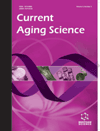- Home
- A-Z Publications
- Current Aging Science
- Previous Issues
- Volume 11, Issue 4, 2018
Current Aging Science - Volume 11, Issue 4, 2018
Volume 11, Issue 4, 2018
-
-
Focus on the Different Projects of Telemedicine Centered on the Elderly In France
More LessAuthors: Abrar A. Zulfiqar, Amir Hajjam and Emmanuel AndrésTelemedicine is now in vogue, allowing computer and communication tools to be deployed in different fields of health, such as Cardiology, Dermatology, areas in which it has received interest, and in international studies. As the population ages, older people are increasingly concerned about this innovative practice. This is a narrative review of both the literature and Internet pertaining to telemedicine projects within the Read More
-
-
-
Oxidative and Inflammatory Events in Prion Diseases: Can They Be Therapeutic Targets?
More LessAuthors: Kedar N. Prasad and Stephen C. BondyPrion diseases are a group of incurable infectious terminal neurodegenerative diseases caused by the aggregated misfolded PrPsc in selected mammals including humans. The complex physical interaction between normal prion protein PrPc and infectious PrPsc causes conformational change from the α- helix structure of PrPc to the β-sheet structure of PrPsc, and this process is repeated. Increased oxidative stress is o Read More
-
-
-
The Effects of Healthy Ageing on Cerebral Blood Flow Responses to Cognitive Testing
More LessBackground: Transcranial Doppler Ultrasonography (TCD) can be utilised to measure the tight coupling of cerebral blood flow velocity (CBFv) in response to cognitive demand by task activation, termed neurovascular coupling. Aims: To investigate the differences in neurovascular coupling between healthy older (>50 years) and younger (18-49 years) adults in response to cognitive testing. Methods: Fifty-four older (n=25) a Read More
-
-
-
Inflammatory Biomarkers, Depressive Symptoms and Falls Among the elderly in Panama
More LessBackground: Falls are common among elderly adults, and are predictors of hospitalization, institutionalization and mortality. Objective: The objective of the present study was to examine the relationship between blood-based markers of inflammation and fall events in a sample of elderly Hispanic adults. Method: Data were collected from 190 participants enrolled in the Panama Aging Research Initiative study who complet Read More
-
-
-
Detecting Non-cognitive Features of Prodromal Neurodegenerative Diseases
More LessBackground: Prodromal Neurodegenerative Disease (ND) due to tauopathies such as Alzheimer’s Disease (AD) and Synucleinopathies (SN) such as Parkinson's Disease (PD) and Dementia with Lewy Bodies (DLB) present subtly. Although ND are considered cognitive disorders, in fact ND present with behavioral and even medical symptomatology years to decades prior to the onset of cognitive changes. Recognizing prodromal ND Read More
-
-
-
Mitochondrial Common Deletion Level in Blood: New Insight Into the Effects of Age and Body Mass Index
More LessAuthors: Mahboube Ahmadi, Masoud Golalipour and Nader M. SamaeiBackground: Age-related decrease in mitochondrial activity has been reported in several tissues. Reactive Oxygen Species (ROS) produced from defected mitochondria lead to aging and accumulate through time. However, studies about the mitochondrial DNA mutation level in blood are contradictory. Other lifestyle factors may modify the effects of age in post-mitotic tissues such as blood. The BMI represents the sum of Read More
-
-
-
Changes in Body Composition of Old Rats at Different Time Points After Dexamethasone Administration
More LessAuthors: Maire Aru, Karin Alev, Ando Pehme, Priit Purge, Lauri Õnnik, Anu Ellam, Priit Kaasik and Teet SeeneBackground: Aging leads to changes in skeletal muscle quantity and quality and is accompanied with increase in body mass and fat mass, whereas fat-free mass either decreases or remains unchanged. The body composition of rodents has been an important factor for clinical trials in the laboratory. Glucocorticoids such as dexamethasone are widely used in clinical medicine, but may induce myopathy, characterized by mu Read More
-
-
-
Impact of Cardiovascular Factors on Pulse Wave Velocity and Total Vascular Resistance in Different Age Group Patients with Cardiovascular Disorders
More LessBackground: Pulse Wave Velocity (PWV) is the propagation speed of the wave-induced along the aorta and arterial tree, each time the heart beats. PWV increases with increased arterial stiffness, thus establishing it as a reliable prognostic marker for cardiovascular morbidity and mortality. On the other hand, Total Vascular Resistance (TVR) is the overall resistance offered by systemic circulation and pulmonary circulation. This r Read More
-
Volumes & issues
Most Read This Month
Article
content/journals/cas
Journal
10
5
false
en

Most Cited Most Cited RSS feed
-
-
Polyphenols and Aging
Authors: Brannon L. Queen and Trygve O. Tollefsbol
-
- More Less

